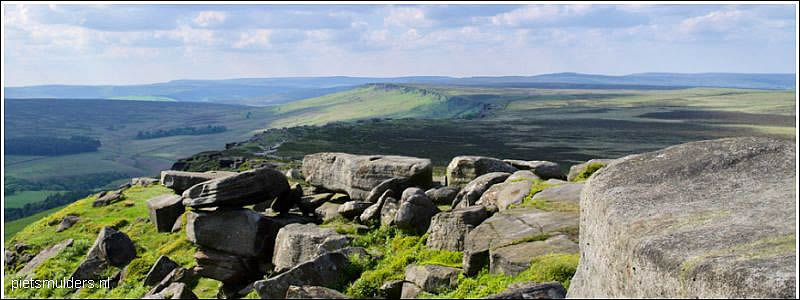.
.........UPLANDS IN ENGELAND
.
Upland:
= land lying above the limit of enclosed (omheind) farmland. Die grens ligt gewoonlijk op grofweg 1,000 feet (±300m) boven
zeeniveau.
Het is dus alles boven de Fell wall, m.a.w. de Open fell, dus de Outfield.
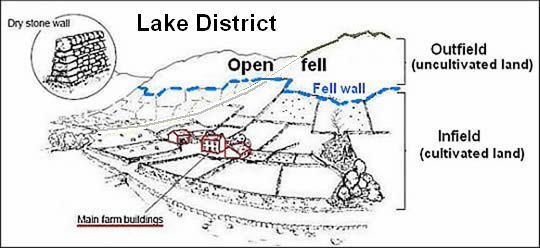
• Als voorbeeld een boerderij in het Lake District in Noord-Engeland.
• Het upland is de Open fell boven de Fell wall, dus de Outfield (het onbewerkte gebied, het buitengebied, de wildernis).
Infield-outfield farming:
Infield-outfield farming is broadly defined as a type of farming system utilizing its area at two different levels of intensity: an intensively farmed infield and an outfield exploited at a low intensity.
(In het Noors noemt men ze Innmark en Utmark)
![]() Infield = het binnengebied, d.w.z.
Infield = het binnengebied, d.w.z.
1. het bewerkte gebied (cultivated land; in cultuur gebrachte gebied).
2. dicht bij de boerderij.
De infield wordt intensief gebruikt. Denk aan ploegen, maaien, bemesten.
![]() Outfield = het buitengebied, de wildernis), d.w.z.
Outfield = het buitengebied, de wildernis), d.w.z.
1. het onbewerkte gebied (uncultivated land ; niet in cultuur gebrachte gebied),
2.
ver van de boerderij.
De outfield wordt extensief gebruikt bijv. voor 't weiden van vee.
Ook in Nederland kenden we in het verleden infield-outfield farming. Denk aan het esdorpenlandschap, waar de essen(1) en de groenlanden (2) (de graslanden (wei- en hooilanden) in het beekdal) samen de infield vormden. De heide(3) was de outfield.
Upland habitats in Britain:
• Covering about a third of the UK’s land surface, upland habitats form the
bulk
of our wildest, most scenic and possibly most romantic countryside.
They are the open habitats of mountains,
moors (venen), blanket bogs (spreihoogvenen) , heaths and rough grasslands.
•The setting for many atmospheric novels from Wuthering Heights to
The Hound of the Baskervilles.
•The uplands are characterised by:
1. older, harder, more resistant rocks, which
form blocks of higher ground.
2. the soils are often less fertile making them less favourable for farming.
3. the climate, tends to be more severe.
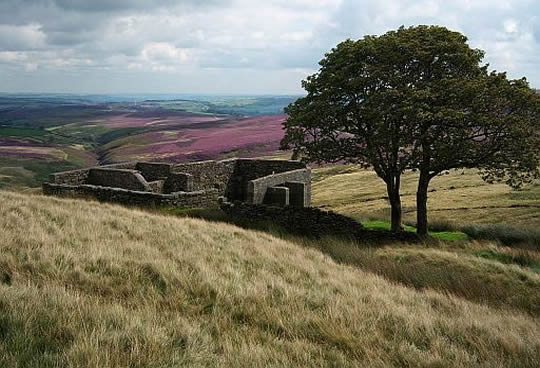
• Top Withens, Haworth Moor. This ruined farmhouse, is the supposed setting for Wuthering Heights in Emily Bronte's novel.
Krantenartikel:
George Monbiot: Why Britain's barren uplands have farming subsidies
to blame.
The hills have been grazed to destruction and it's time we
begin to
challenge
the irrational aspects of the farming funding system.
Zie: www.theguardian.com/e
Video ( 9 minuten):
George Monbiot: hills are 'sheep-wrecked' and in danger
Zie: www.youtube.com/watc
Mooie video: Rewilding (= herwildering) with George Monbiot:
George Monbiot:
Cross that bleak plateau and you will see plenty of moorgrass, some
tormentil
and moss, a few crows, perhaps the odd pipit and skylark, but
almost nothing
else, except sodding sheep. The hills have been grazed to
destruction'.
We zien een frappant verschil tussen de uplands van
het Europese
vasteland
en die van Groot-Brittannië (en Ierland).
Die van het continent zijn bebost (denk bijv. aan de Ardennen).
Dat is de normale gang van zaken bij uplands met hun relatief
ruige klimaat
en arme
bodem.
In Groot-Brittannië zijn ze echter niet bebost (denk aan de kale Pennines).
George Monbiot legt in een prachtige lezing uit hoe dat komt.
Warm aanbevolen.
Zie: www.youtube.com/watch?v=
...Rewilding (herwildering) = the mass restoration of ecosystems. |
| aaaa |
Upland areas in Britain:
Op de onderstaande kaart kun je de uplands goed vergelijken tussen Engeland, Schotland en Wales.
...Upland = land lying above the limit of enclosed (omheind) farmland.Die grens ligt gewoonlijk op grofweg 1,000 feet (± 300m) boven
zeeniveau. |
Schotland en Wales hebben beide relatief veel upland. In Schotland
is een groot
gedeelte daarvan zelfs boven de 2,500 ft (±760 m).
Ook zijn er
in Schotland eilandjes aan de westkust met upland en ook
hier is een gedeelte
nog boven de 2,500 ft (±760 m) is.
| ...Upland areas in Britain . (= lichtbruin + donkerbruin) |
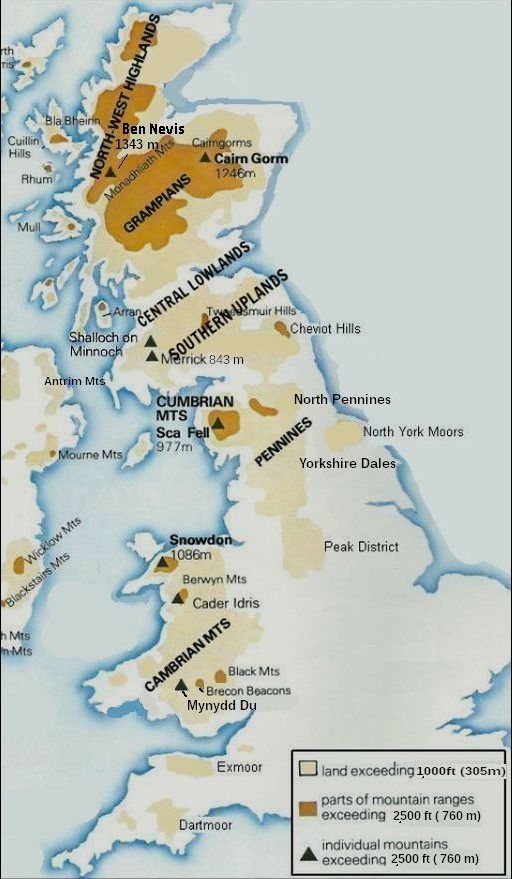
• De uplands zijn in de kaart de licht- en donkerbruine gebieden samen.
• Most of our upland habitats are found in Scotland, Northern England and Wales, though there are some areas of moorland in South West England.
• Towards the north of Britain the climate, soils and terrain become more challenging for plants and animals, so that some areas almost at sea level in Northern Scotland or the Hebrides still feel part of the upland rather. than the lowland zone.
| aaaa |
Upland regions in Engeland:
• If one divides England into broad-scale zones based on vegetation and
environment, including climate, a particularly important division is seen
between upland England (the cooler, wetter north and west), and lowland England (the warmer, drier south and east).
• The difference between these areas is shown, for example, by thegreater
extent of peat and the greater quantity and diversity of
humidity-
demanding
bryophytes
(liverworts and mosses) and ferns in upland England, and
the greater quantity
of
thermophilous or
heat-demanding plant species in lowland England.
Trek een diagonaal door Engeland vanaf de oostrand van de
North York Moors naar de oostrand van Dartmoor.
De uplands bevinden zich dan allemaal ten
noordwesten van die lijn.
(Ten zuidoosten v. d. diagonaal is alles lowland).
Lowland komt grofweg overeen met lager dan 1,000 feet (± 300 m). Dus ook bijv. het Cotswold plateau is lowland, want bijna helemaal
onder
de 1,000 feet (slechts enkele topjes steken er bovenuit).
Ook alle andere heuvelruggen in het zuidoosten behoren tot de lowlands.
Denk aan bijv. North Downs, South Downs, The Chilterns, etc.
( Als we de termen upland en lowland op de Benelux toepassen, dan
zijn de Ardennen het upland. De rest is lowland.
...Upland = land lying above the limit of enclosed (omheind) farmland. Die grens ligt gewoonlijk op grofweg 1,000 feet (± 300m) boven zeeniveau..... |
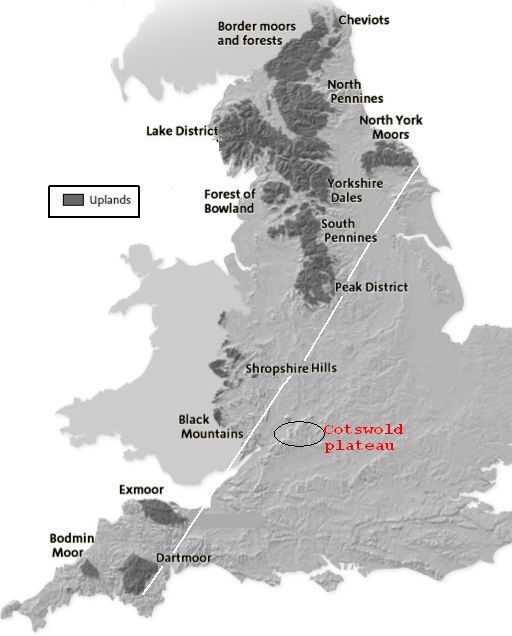
Upland regions (van noord naar zuid):
• Cheviot Hills (815 m = hoogste top)
• Border Moors and Forests
• North Pennines (893 m) (The Pennines are considered to end in the north at the River Tyne gap; dus ongeveer ter hoogte van
Hadrian's Wall)
• Lake District (978 m)
• North York Moors (454 m)
• Forest of Bowland (561 m)
• Yorkshire dales (736 m)
• South Pennines ( ..)
• Peak district (636 m) (dit is het zuidelijke uiteinde van de Pennines)
• Welsh Borders: Black Mountains (... m), Shropshire Hills (540 m), etc.
• Exmoor (519 m), Dartmoor (621 m) en Bodmin Moor.
| aaaa |
What are uplands ?
• The British uplands, which cover almost a third of Britain's land
surface, encompass a wide range of habitats ranging from places such as:
- the
granite
tors on Dartmoor, through
- the eroded peat plateau of Kinder Scout (Peak District) to
- the
arctic-like plateau of Ben MacDui in Scotland.
• Despite the obvious differences between these places each is instantly recognisable as an upland environment, so what do they share in common ?
One important
shared characteristic is the absence, or at least the paucity (= schaarste),
of human signs such as roads, buildings and
boundaries. They are the closest that we can get to wilderness in Britain.
• The adjectives that people use to describe upland habitats depend
upon their
point of view, but range through words as open, wild, empty, bleak, desolate and hostile.
Each of these adjectives picks up on particular features of upland environments that are a consequence of:
- the absence of cultivation,
- the
topography (shape of the land)
and
- the climate.
• There is
little doubt that the upland landscape is valued in Britain since many
of the National Parks have a significant amount of upland habitat.
...Upland = land lying above the limit of enclosed (omheind) farmland. .Die grens ligt gewoonlijk op grofweg 1,000 feet (± 300m) boven
zeeniveau. |
Although the word upland and this definition, implies an altitudinal
boundary,
the altitude (=hoogte) of the land is really a surrogate for climate, since the
position of the boundary between lowland and upland is related to the effect
that weather has
on plant growth.
• The limit of enclosed farmland is an economic threshold, above which
it is unprofitable to cultivate the land. Farming close to the boundary
is
always marginal and changes in agricultural funding could move
the
boundary up or
down the hill.
• The boundary between lowland and upland can often appear sharp,
with
markedly different vegetation above and below the wall or fence (afrastering) marking the
upper limit of a farm.
This sharp transition in vegetation across a farm boundary
wall or fence
is a consequence of the relatively intensive management that
takes
place on the farm. The real ecological boundary between the lowlands
and
the uplands is much more fuzzy but, none the less, real.
• Although the uplands are unlikely to suffer from the urbanisation or
intensive
farming experienced in the lowlands there are other threats that are direct
consequence of our actions.
For example, there is habitat degradation
brought
about by:
- overgrazing,
- commercial afforestation
- recreation
- persecution of
wildlife and
- the insidious (= verraderlijke) effects of acid deposition and global warming.
All of these are a threat to the naturalness of the upland environment
and to
their value as wilderness areas.
| aaaa |
Important upland semi-natural habitats:
Most of the uplands have been modified through grazing, drainage,
tree-planting and deposits of atmospheric pollution.
The uplands are perhaps most memorable characterised by
a mosaic of bleak, open unenclosed (=niet omheind) landscape of:
1. Blanket bog (=spreihoogveen),
2. Upland Heaths,
3. Upland Grassland
| aaaa |
1. Blanket bog (=spreihoogveen):
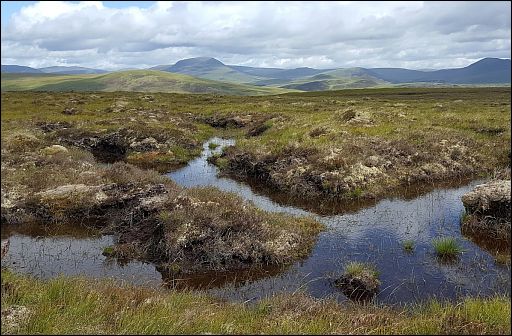
As the name suggests, blanket bogs form over a large area and are
typically
shallow (a few metres).
They form in areas of high rainfall (upland areas and west coast) where
high levels
of acid leaching occur.
They are called blanket bogs (spreihoogvenen) because of their appearance - from a
distance they appear homogeneous and they hug the topography like
a blanket.
Contrary to popular belief, blanket bogs are essentially a man-made
feature, if inadvertent (onopzettelijk) and aided somewhat by the
climate.
Blanket bog (=spreihoogveen): is an open habitat almost entirely restricted to the uplands in England and Wales, but which descends to sea level in parts of
Scotland.
It is characteristically underlain by an expansive ‘blanket’ layer of peat.
This develops because the climate is sufficiently cool and damp to
allow peat-forming plants to grow – the litter of which decomposes
very slowly
under
the permanently water-logged conditions and
gradually accumulates
into a
layer of peat.
(Examples of peat forming species are Sphagnum mosses and cotton grasses(het geslacht wollegras)).
The peat depth and time over which it has accumulated are very
variable –
usually it is between 0.5–3 m thick and dates back
5–6,000 years.
The main causes of the spread of blanket bog are debated – although
in
some
areas this initiated following clearance of the original forest
cover by
man, this
co-incided with a general natural cooling in climate
conditions.
| ...BLANKET..BOGS . (SPREIHOOGVENEN). BY . REGION |
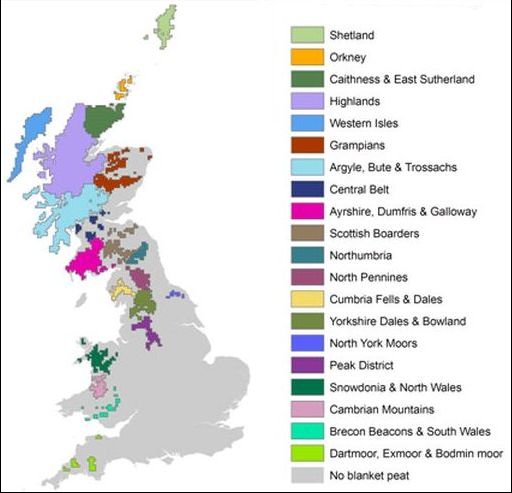
• Blanket bogs by region based on 5 km gridded data of blanket peat presence.
http://www.peakdistrict.gov.uk.
| aaaa |
2. Upland heaths :
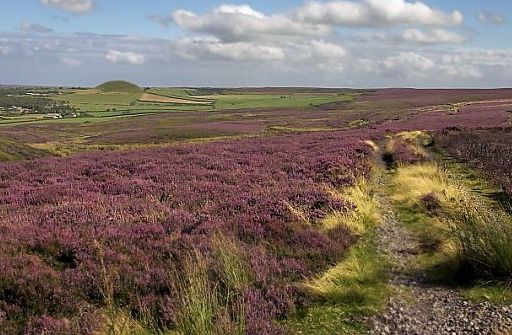
• Upland heath ( heather moor) in the North York Moors.
• Het is niet omheind (unenclosed) heideveen dat beheerd wordt voor grouse shooting.
.
Upland heath occurs on steeper slopes than blanket bog. It occurs on mineral soils and thin peats < 0.5 m, and is characterised
by a cover of dwarf shrubs of
at least 25%.
(Blanket bog is distinguished from heathland by its occurrence on deep peat (> 0.5m) and gentler slopes.)
Typical shrub species include:
- Heather (Calluna vulgaris) (Struikhei),
- Bilberry (Vaccinium myrtillus) (Blauwe bosbes),
- Crowberry (Empetrum nigrum) (Kraaihei) and
- Bell heather (Erica cinerea) (Rode dophei).
- Juniper (Jeneverbes) is often found on upland heaths in northern areas, whilst
- Western gorse (Ulex gallii) (Westelijke gaspeldoorn) occurs in the south and west.
Wet heath is more commonly found in the north and west where the
climate is damper.
Here typical plant species are:
- Cross-leaved heath (Erica tetralix) (Gewone dophei),
- Deer grass (Scirpus cespitosus) (een Bies-soort),
- Heather and Purple moor grass (Molinia caerulea) (Pijpenstrootje) ,
- with a carpet of mosses including Sphagnum species. (Veenmos spp)
http://www.peakdistrict.gov.uk.
| aaaa |
3. Upland grassland:
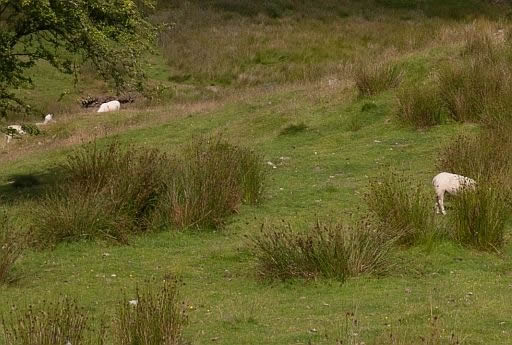
• Upland acid grassland and rush pasture.
Upland grasslands are the result of human intervention through
livestock grazing.
They are found throughout the English uplands and are generally unenclosed and subjected to extensive livestock grazing.
Underlying geology, soil type and historic land use are significant
drivers of distribution.
The most common grassland is acid grassland consisting of bents,
fescues, mat-grass and wavy-hair grass.
More nutritious grasslands occur on areas of fertile or lime-rich soils.
| aaaa |
Weet je aanvullingen en verbeteringen van deze tekst?
Graag een e-mail naar:
![]()
Extra info voor de liefhebbers:
....The upland farming system – a Cumbrian example ..............
• The upland farms comprise here: the farmyard and three land types: 3. In the open fell is the unenclosed(niet omheind) rough grazing. It is lying above the fell wall.
|
.... History, land use and management: |
..
Weet je aanvullingen en verbeteringen van deze tekst?
Graag een e-mail naar:
![]()
LAATST BIJGEWERKT : 7-1-2019
